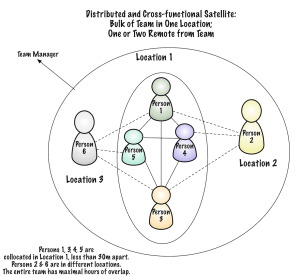Five Tips for Your Successful (Hybrid Remote) Satellite Team
You’ve spent the better part of two years organizing for all-remote work. Now, your managers want people back in the office. However, your team won’t all be back in the same time and space. People get to choose which days (and possibly hours) they come into the office. That means you don’t have a collocated team. You also don’t have a fully remote (nebula) team. You have a hybrid team—specifically, a satellite team. While satellite teams often create the worst of all possible worlds, here are several ideas to make your satellite team successful.
You might think that when people “return” to the office, all of the team’s collaboration will get easier. Not in my experience. First, lets’ discuss what you did to make your nebula team successful.
(If you’re not sure what these team types are, read How To Understand Your Team Type: Collocated, Satellite, Cluster, Nebula.)
Ways You Made Your Nebula Team Successful
When everyone is remote, you noticed that the Allen Curve—your physical distance—wasn’t a barrier to effective communication. You could work together. Here’s what you did:
- Created and used a text backchannel for all kinds of communication, both synchronous and asynchronous.
- Chose when to work collaboratively. (You may have created an hours of overlap chart.)
- Determined and acquired the equipment you needed.
If you’re like most of the people I work with, your team got pretty good at remote work. You used video and created useful times to work.
Now, your nebula assumptions change with satellite teams. Let’s first talk about what’s different about the satellite team, the traps.
See Your Satellite Teams Traps
Let’s imagine a 6-person team: 3 developers, 2 testers, one product owner. When do they work where, once they’re hybrid?
- Mondays and Wednesdays, the product owner, one developer, and one tester are in the office.
- Tuesdays and Thursdays, the other two developers and one tester are in the office.
- Fridays, everyone chooses where they work. Most people choose to work in their homes.
This team isn’t the same throughout the week. Monday through Thursday, the team is a satellite. And, not the same satellite, because people change locations. On Friday, the team is a nebula team.
When Mark and I wrote From Chaos to Successful Distributed Agile Teams, we saw these satellite team traps:
- People in the office forgot about the people not in the office.
- The team doesn’t know how to effectively collaborate.
- Worse, the team doesn’t know how to integrate new people into the team.
- A satellite team needs different working agreements.
- And, this team also needs nebula working agreements.
Your team might encounter other traps.
How can you deal with these hybrid team traps?
Tips for a Successful Satellite Team
Let’s start with how the team will work together. While we might call all these things, “meetings,” let’s assume the team will workshop. (See Decide When You Need to Meet, Workshop, or Write to Save Energy and Time to discuss the purpose of this meeting.)
Then, consider a checklist for the basics:
- Choose a facilitator each and every time. That person sends an agenda and arranges the “place” everyone will meet.
- Find a way to “turn on” video for everyone? (You might need a separate tool, such as an OWL to make it possible for everyone to see and be seen.)
- Arrange for sufficient bandwidth so everyone can fully participate.
- If you don’t have a tool such as an OWL, ask everyone to join the meeting from their desks. That means people need to wear headsets, have good cameras and lighting.
- Use the backchannel in the meeting. Don’t rely on people talking to each other.
In addition, your team might need to specify different working agreements for the satellite time vs. the nebula time.
Summary
When teams change their characteristics, change how you meet. Change your working agreements. Look for collaboration time and location—and don’t think that going into the office makes anything better. Get the equipment you need. And use that backchannel.
Until you see and resolve your satellite team traps, you can’t make your satellite team as effective as your nebula team. Too many hybrid teams are not as effective as remote or collocated teams. See what you can do to make your satellite team successful.
Published on Java Code Geeks with permission by Johanna Rothman , partner at our JCG program. See the original article here: Five Tips for Your Successful (Hybrid Remote) Satellite Team Opinions expressed by Java Code Geeks contributors are their own. |



